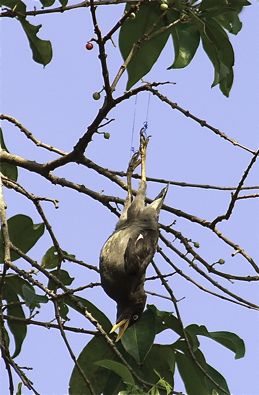Leslie Joseph a.k.a. sirkopio came across a Javan Myna (Acridotheres javanicus) dangling from a discarded fishing line in May 2009 at Bidadari. So upset was Leslie that an appeal was made in the NaturePixel.org forum reminding amateur fishermen to be more responsible and not discard their used lines all over the place. Earlier, Leslie had a similar encounter but the tangled bird was saved. Not this time as it was too high up and probably already dead when he saw it.
John Vickerman responded: “Yes, graphic pictures once again telling an all too common and tragic story of global proportions. As you rightly say, NEVER just throw ANYTHING away. Always safely dispose of unwanted items. If it’s a tin can, a polythene bag, string or nylon line (or any thread), some creature is likely to get stuck in it with usually fatal consequences.
“And it’s not just on land that there is a problem. Many billions of birds, fish and mammals roam the seas of the world – and we all know the problems that face dolphins and albatrosses to name but two. For evidence of the traps awaiting any sea-going creature just look at the tide-line of any shore anywhere in the world. It beggars belief what gets heaved into the seas of this planet!
“Education… education… education… It’s a long slow process, but there’s no excuse for doing nothing. Wider publication, especially in schools, of just these kinds of images can go some way to getting messages across about responsible disposal of waste items.
“Truly evocative and emotive pictures Sirkopio – I hope they can be put to good use in schools or any other educational centre concerning conservation issues.”
This is the fourth post on birds strangled by discarded fishing lines. Our earlier two posts were on herons strangled in Singapore’s West Coast Park and Punggol Park. The third post was about an owl entangled at the Lower Peirce Reservoir that was eventually rescued.
This post is a cooperative effort between NaturePixels.org and BESG to bring the study of bird behaviour through photography to a wider audience.










4 Responses
YC – hello once again.
Quite rightly, you have highlighted the problems that will occur if anglers do not take away and safely dispose of waste line and hooks. Angling is the world’s most popular participant sport, and responsibly carried out, is environmentally safe.
But there are many incidents from all around the world of human indifference and ignorance concerning the impact on and suffering of wildlife caused by discarding unwanted materials and not safely disposing of them. There continue to be many incidents where tangled lines and hooks are quickly and easily cut free – and then merely left where they lie or hang. The sad consequences of conflict with wildlife then become apparent when we see such pictures as photographed by Leslie Joseph (a.k.a. Sirkopio) and others of birds killed by entanglement with discarded lines; all avoidable deaths.
Education rather than confrontation has to be the preferred course of action in addressing such global issues. Clearly, educational participation on the ground by Park Rangers where appropriate is an essential ingredient in combating indifference and ignorance. Slapping a heavy fine on someone the first time they are caught is not necessarily a good public relations exercise! But education in teaching a healthy respect for wildlife must start at an early age, if not at home, then in school, and I believe the sorts of pictures that have been published on the website concerning the slow and distressing deaths of a variety of bird species should be used in schools and any other learning centre where environmental health and safety issues – and waste disposal – are, and should, be taught and debated.
YC, there are very many aspects of “waste” about which thousands of papers and weighty tomes have been written. It is relatively easy to discuss aspects of “waste” concerning recreational angling, but much more complex arguments arise if one is going to extend discussion of the problems of waste management and disposal to, for example, the economics of running a viable business (either small or large scale), associated pollution and so on.
But we ignore these problems at our peril! In moving on, we must strive to ensure that tomorrow is a better and safer day for our wildlife and ourselves together than was the case yesterday, or is today. The overall objective, in my opinion, should be to minimise waste in the first place, and then render harmless and safely dispose of, and recycle where possible, that which we do produce. To simply discard stuff as the fancy takes us is no longer an option.
Best wishes,
John.